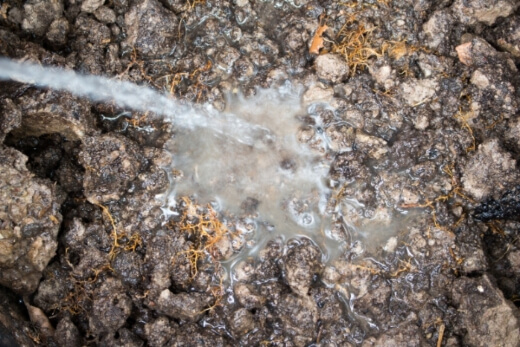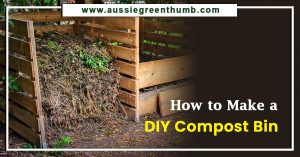soil is a common issue in Australia, and it can be incredibly frustrating for gardeners and farmers alike. When the soil won’t absorb moisture, plants can become stunted or die off even with regular watering.
In our guide, we’ll give you some insight into the causes of hydrophobic soil, how to identify it, and hydrophobic soil treatment – including some wetting agents on the market.
More...
What is Hydrophobic Soil?
Hydrophobia is the extreme or irrational fear of water in humans. It makes sense then that the ‘fear of water’ for soil, or water repellent soil, is called hydrophobic. It is a common problem for many gardeners, especially those with sandy soil types.
Sandy soils (<5 % clay) are most susceptible to being water repellent. Because sandy soil has a small surface area, the individual particles are more easily coated in hydrophobic material, compared to clay soils. Hydrophobic soil is often known simply as non-wetting soil.
How do I test if my soil is water repellent?
If you are watering regularly but still have wilting pot plants and veggies, stunted plants and dry patches of lawn, these are all good indicators of water repellent soil.
How do you know for sure if you have a problem with the soil? You can easily identify hydrophobic soil by watering it. Get your watering can or hose and put a small amount of water onto the soil in your garden, lawn or potted plant.
When water is poured onto the soil, does it pool, bead or run-off to the sides. If the water doesn’t absorb, you have hydrophobic soil. The longer absorption takes, the worse the problem.
What Causes Hydrophobic Soil?
Unrotted organic matter, native tree leaves and uncomposted mulches can deposit waxy, oily material on the soil particles. Fungi in the soil can also lead to excessive build-up of organic residue and waxy like substances in the soil.
When the soil dries out, this waxy coating on the grains won’t let water back in and soil remains dry. The more that the soil particles are coated, the more water repellent the soil is.
When soil particles get coated in waxes, water skims off the top or pools on the surface. The waxy residue stops water from being absorbed.
Water repellent or hydrophobic soil is one of the worst problems facing gardeners today, especially those living in coastal areas, western and southern Western Australia.
Hydrophobic Potting Soil
Water repellent soil isn’t just a problem in your outdoor garden. Many potting soils also become hydrophobic, when they dry out, making them difficult to re-wet.
It is easy to spot hydrophobic potting soil. Water drains quickly but doesn’t really wet the soil. Water typically pools on the top and then drains quickly down between the pot sides and the soil.
Unfortunately, this means only a small percent of the soil gets wet and most of the soil around the middle area remains dry. In this situation, potted plants will wilt and dry out from lack of water reaching the roots.
Hydrophobic Lawn Soil
If you have dead patches, localised dry spots or brown areas, then it is likely you have hydrophobic lawn soil. The lawn soil is repelling water rather than absorbing it, resulting in a dry lawn root zone, even if you are watering regularly.
Growth may be patchy, and the random nature of the effect often gets confused with fungal disease. Because water doesn’t sink in properly, and just pools and evaporates, the lawn suffers from drought stress. The problem of hydrophobic lawn soil is exacerbated during Australia’s long, hot, dry periods.
Why Treat Water Repellent Soils?
Simply put, no matter how often you water your plants or lawn, they won’t get enough water to thrive. You are wasting your time and water.
Hydrophobic soil also makes it difficult for seedlings and newly planted plants to establish their roots. Moisture on the surface can lead to plant disease in more established parts of the garden. Poor water absorption also impacts root depth, making your plants and lawn less drought tolerant.
How to Fix Hydrophobic Soils
The good news is that water repellent soil can be treated and repaired. The most common approach is to use a wetting agent or soil wetter. They work like detergent, breaking down the waxy coating on the soil particles, making water easier to penetrate the soil.
Wetting agents are a quick fix but need to be applied semi-regularly. Consider them a short-term fix only.
The best long-term solution to hydrophobic soil is to add easily decomposable organic matter. Improving the soil will prevent it from drying out and bring back good microorganisms that break down the waxy and oily material, along with the organic matter.
After improving the soil make sure to mulch, but avoid eucalypt wood mulch. Australia’s CSIRO research suggests that lime, which helps raise soil pH levels and favours wax-degrading bacteria and other soil microorganisms, may be helpful in reducing water repellency.
Fixing Hydrophobic Potting Soil
First things first, if the potting soil is very water repellent, then you might need to remove a couple of centimetres of the topsoil first and replace it with new potting soil or compost.
The easiest way to fix and repair water repellent potting soil is the dunking approach. Simply lift and submerge the entire pot in a bucket of water. There could be lots of air in the soil, so you’ll see bubbles and may need to hold the pot under. Keep it submerged in the water for 20-30 seconds and then remove.
In the bucket of water, it can be useful to include a capful of liquid wetting agent and another cap of liquid fertiliser, such as liquid kelp or fish emulsion. While you’re fixing the hydrophobic potting soil you are also improving the soil health and stimulating plant root activity.
For harder to lift, large pots, you can put a hose in the pot and slowly trickle water. Make sure there is little flow as you want the water to enter slowly enough that it can be absorbed instead of pooling on the top and running down the sides.
As with the dunking approach, it can be good to also add a wetting agent and some liquid fertiliser.
How to Fix Hydrophobic Lawn Soil
Don’t waste more water on your lawn. Aerate the lawn to alleviate soil compaction and apply a wetting agent. Using a liquid wetting agent on your lawn should ensure that rain or watering penetrates the soil evenly and promotes good, healthy growth.
As an added benefit you also reduce water wastage as the water won’t just evaporate or runoff. Goodbye patchy lawn!
Soil Wetting Agents

Soil Wetting Agents Frequently Asked Questions
Do Soil Wetting Agents Work?
These products break down the waxy coating on soil particles and reduce the surface tension of the water molecules, so moisture sinks into the soil more easily where roots can access it.
The added moisture in the soil helps promote bacteria growth and other microorganisms that are essential for a healthy soil biome, overall improving the nutrients in the soil, aerification, and overall soil condition.
What is the Best Soil Wetting Agent?
The best soil wetting agent is one that works quickly, improves sandy or clay soils, breaks through water tension to help moisture absorb to root level, and delivers lasting results.
It’s also a good idea to look for a soil wetting agent that is safe for your garden, whether that means it is organic, safe for fruits and vegetables, or safe for new plants.
Can You Use Dishwashing Liquid as a Soil Wetting Agent?
Hydrophobic soil has waxy molecules that cause water to run off, and soap can help break these down. We recommend trying an organic and biodegradable dishwashing liquid to avoid affecting your plants or the environment, mixing 1 teaspoon of the liquid with 3 litres of water.
Are Soil Wetting Agents Safe?
If you have native plants, it is essential that you use an Australia Certified Organic (ACO) product and stick to manufacturer guidelines, as this is the safest option for these sensitive plants.
Other soil wetting agents may not be appropriate for vegetables and other consumables, and some should not be used on new plants or sprayed onto foliage.
Can You Apply Too Much Wetting Agent?
Usually, you cannot damage your garden by applying too much soil wetting agent. Overdoing it simply wastes the product rather than harming the plants.
However, some soil wetting agents shouldn’t be applied to new plants or foliage as this can burn the plant. As always, we recommend following manufacturer instructions for applications, especially if you are using a liquid concentrate.
Here are some soil wetting agents we have found.
My 2 Favourite Soil Wetting Agents in Australia
1. Penterra Soil Penetrant and Wetting Agent
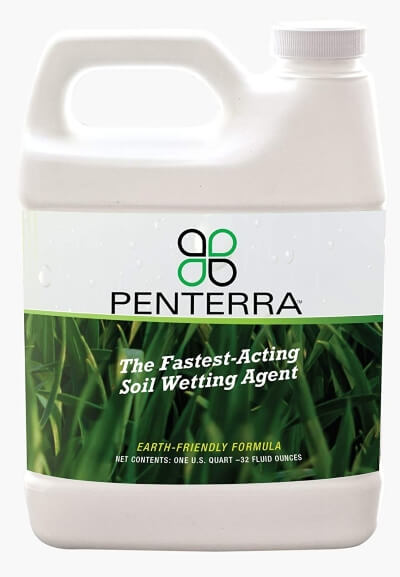
Used in gardens as well as on golf courses, crops, and athletic fields, this professional-grade wetting agent helps to restore a healthy soil biome and retain water.
It helps break up heavy clay soils and strengthen plant roots, helping plants get the nutrients and moisture they need through hot or dry spells. The ingredients are earth-friendly too.

Pros
Cons
2. Yucca Organic Wetting Agent and Surfactant

This organic soil wetting agent is an excellent surfactant, reducing the barrier on hydrophobic soil to ensure good penetration and minimal runoff and erosion.
It’s made from Yucca Schidigera extract and contains 60% saponin, a natural compound that foams and naturally breaks down water molecules for improved absorption.
It’s more evenly absorbed by plants and will not spot the leaves, and it helps protect plants from environmental stress and damage.
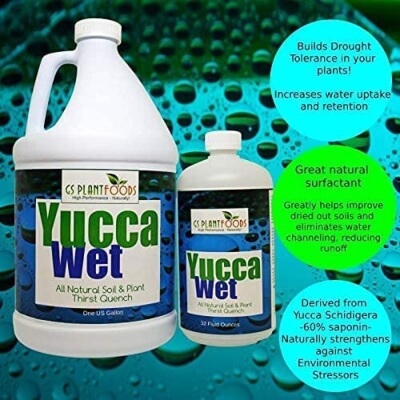
Pros
Cons
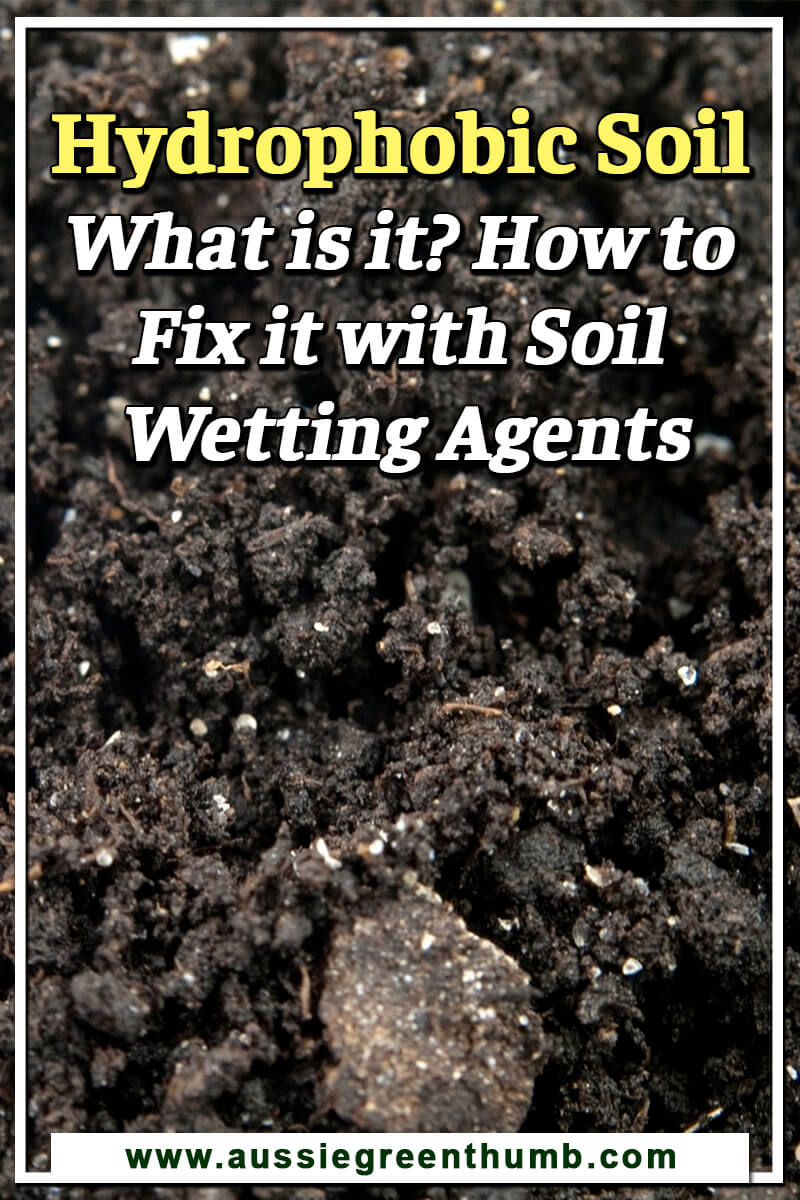
Wrapping Up Our Hydrophobic Soil Guide
The best way to fix any soil issue, is to keep it happy. Healthy soil will generally not have problems like water repellency. To know more about healthy soil, check out our loam soil guide.
Working a good, well aged, organic compost through your soil, watering it regularly, and keeping the microbial activity churning along will help reduce any chance of that annoying waxy residue accumulating.
Using soil problems like this is a great excuse to give your garden a bit of love and TLC and get them back to where they need to be for healthy happy plants.
Making sure you have a good soil mix that will also aid in allowing plenty of space between the soil pores for water to infiltrate. Hydrophobic soil isn't great, but it's not the end of the world.
Published on August 31, 2021 by Nathan Schwartz
Last Updated on January 12, 2024

